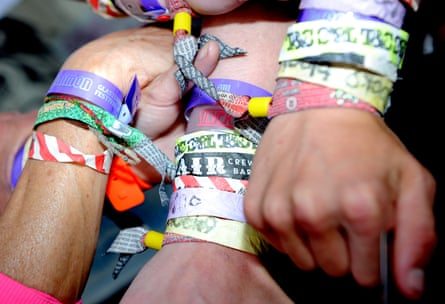There is a moment during any music festival when I want to tear my skin off and go home. It’s not after the two-plus days of wet wipe “showers”. Or the thigh burn from hovering above a toilet seat (if there is one). Or even the powerful smell of aged cheese and human waste that’s released from the ground on the final day. This moment can happen minutes, even seconds, into the weekend. And it will continue to happen many times a day for however long the thing goes on.
This moment is triggered whenever I have to wash my hands, and the dangly bit of the wristband will inevitably get wet and stay like that for at least an hour. Maybe longer. You can ignore it for a while, but then you’ll give someone dressed like a banana a high five and you will feel it, moist and scratching, against your forearm. If you’re wearing long sleeves, forget about it. It will press against the cotton and create a soggy patch that will nag you for hours, like a 4am drum circle one campsite over. Showering? A sensory nightmare. What I’m saying is: wristbands are a necessary but annoying part of “festival admin”. You wear them because you must.
I cannot imagine, then, paying €3,500 (£3,000) to have one clamped on in exchange for no festival at all. But some people are about to do that, because this is what Balenciaga is selling as part of its autumn/winter 2024-25 haute couture collection.

Debuted in Paris last week, the “raver bracelet” is an accessory designed to resemble a festival wristband that’s been slowly disintegrating on you for years. It’s hand-embroidered using “various artisanal techniques” to appear “worn and aged” in a way that requires a full day of work to create. For this reason, you can get one by appointment only.
It’s difficult to say who this is for exactly. Demna, Balenciaga’s creative director, typically goes for a mix of high end and subcultural signifiers that play with expectations of luxury. This involves a viral marketing approach that has involved the release of the T-shirt shirt (a dress shirt stitched on to the front of a T-shirt), the “gaffer bangle” (a roll of clear sticky tape) and a handbag that looks like an empty packet of Lay’s crisps.
after newsletter promotion
The “raver bracelet” follows the same logic, but is rooted more deliberately in 00s skate and metal touchstones. The range also includes a “Dalston ball earring” (the thing they give you when you get the top of your ear pierced), a “handpainted gothic hoodie” (which looks like knock-off metal band merch) and a €15,000 pair of “baggy jeans”. It’s nu-metal pop art; Kerrang! goes Kardashian.
It also taps into the (mostly teenage) obsession with leaving your festival wristbands on for clout. When I was younger, wristbands weren’t the source of irritation in the bathroom that they are now. They were a mark of pride. Military medals that proved you survived the great Glastonbury washout of 1997. That, yes, you were there when the Mars Volta played that three-hour set at All Tomorrow’s Parties in 2005, and experienced new rave summer at Reading and Leeds 2007 when Hadouken, New Young Pony Club, CSS, LCD Soundsystem and Klaxons were billed back to back. They prove that you’re not a newbie, which, when you’re 19, gives you the authority to say things like “Oh, you lugged beer from home? We just get ours from the big Tesco in town … ” with absolute arrogance.
At one point I was rocking four years’ worth of Reading wristbands at once – which is, obviously, foul. They smelled so bad my mam once threatened to cut them off me in my sleep. But my dedication to wearing them came from a place of love and identification with a particular culture. It was an attempt to signify who I was to the world, as it is for the people still wearing them now. There are some who will not be parted from them until they die, that’s how much they mean to them.
And to be fair, the “raver bracelet” does the same. Brandishing an expensive wristband for a non-existent festival makes a very loud statement about what kind of person you are; best of luck to anyone planning on wearing one to Download next year.
Source: theguardian.com


